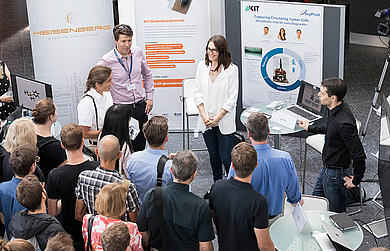LiftWise
People who exercise regularly want to see progress and stay motivated. Liftwise is developing a digital infrastructure for fitness studios. It records the entire workout and makes progress visible. Artificial intelligence helps us to create feedback tailored to the individual user.
Further information: http://liftwise.de/
Litona
Litona develops and produces energy storage materials for rechargeable batteries based on the metal sodium. These offer the opportunity to make Europe less dependent on critical raw materials from third countries and to drastically reduce the prices of stationary energy storage systems for storing wind and solar energy and batteries for electric cars. Litona is currently selling the energy storage materials for these batteries to university and industry research institutes and is scaling up their production in order to supply the whole of Europe with their material in the medium term.
Further information: https://www.litona-batteries.de/
PHABIOC
PHABIOC develops high-throughput screening tools for the pharmaceutical and biotechnology industries to solve complex laboratory challenges. Our products offer advanced analytical capabilities. With the product brands "PermeaPad" and "SpecPlate" we address the increasing demands in drug development by predicting bioavailability in vitro or measuring drug concentrations faster and more reliably.
Further information can be found at www.phabioc.com
Prio Optics
Prio Optics has developed an innovative process for the production of optical interference filters. For the first time, we are printing optical filters with an inkjet printer instead of the usual production in vacuum chambers. The process offers more freedom in terms of filter size, filter structure, substrate material and optical properties, which opens up new areas of application such as advanced microscopy, hyperspectral imaging and building integration. At the same time, it enables lower energy and material consumption.
Spotium
Spotium is the most specific market and sales intelligence software for the mechanical engineering industry and its suppliers. The aim of Spotium is to provide our customers with relevant sales information without any effort on their part. And thus support them in selling more again. In the spirit of "Search less. Sell more".
Further information: www.spotium.de
Valoon
The acceptance of software in the construction, real estate and maintenance industry is very low, especially among workers who are active on site. The reasons for this are ultimately banal. The people involved want to build, not operate software. On the part of the coordinator (e.g. site manager), this leads to forced spontaneous and uncoordinated inquiries via chats, e-mails and telephone and thus to absolutely chaotic communication. Valoon addresses this issue and combines the advantages of project management software, such as structure and clarity, with the acceptance and simplicity of messengers. This is achieved by the coordinator communicating with the participants via Valoon in future, while the workers continue to work with the messengers they are familiar with, such as WhatsApp.
Further information: www.valoon.chat
